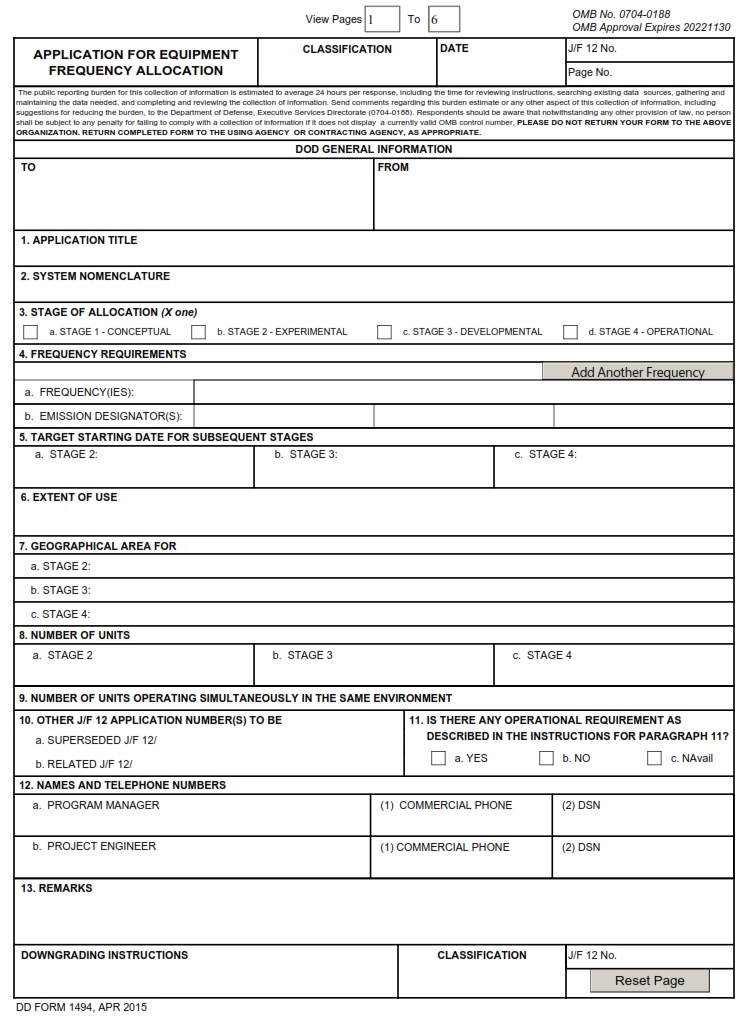Table of Contents
FREE-ONLINE-FORMS.COM – DD Form 1494 – Application for Equipment Frequency Allocation – In the vast landscape of military operations, communication is not just a convenience but a strategic necessity. Imagine an intricate dance of frequencies and signals, each one carrying vital information to ensure the success of missions and the safety of personnel. At the heart of this complex symphony lies the DD Form 1494 – a seemingly mundane application form that holds the power to shape how these frequencies are allocated for equipment use. But behind its bureaucratic facade lies a world of technological intrigue and strategic planning, where every frequency allocation decision can make or break critical communication links in the heat of battle.
As we delve into the realm of DD Form 1494 – Application for Equipment Frequency Allocation, we uncover a hidden realm where military precision meets technological innovation. This seemingly innocuous document serves as a gateway to unlocking access to essential frequency bands that are instrumental in facilitating seamless communication networks across diverse military operations. Through this article, we invite you to journey with us into the captivating world where paperwork meets warfighting technology, shedding light on the crucial role played by DD Form 1494 in ensuring effective command and control capabilities for our armed forces on land, sea, and air.
Download DD Form 1494 – Application for Equipment Frequency Allocation
| Form Number | DD Form 1494 |
| Form Title | Application for Equipment Frequency Allocation |
| Edition Date | 4/1/2015 |
| File Size | 143 KB |
What is a DD Form 1494?
The DD Form 1494 is a crucial document used to request frequency allocations for military equipment. It serves as an application that outlines the specific frequencies needed for various types of electronic systems and devices used by the military. By submitting this form, organizations can ensure their equipment operates within designated radio frequency bands, reducing interference and improving communication efficiency on the battlefield.
One interesting aspect of the DD Form 1494 is its role in promoting spectrum management within the military. With the increasing complexity of modern warfare technology, proper allocation of frequencies is essential for maintaining operational effectiveness and security. This form helps streamline the process by providing a standardized way to request frequency assignments, ensuring that each device has secure and optimized access to necessary radio resources.
Where Can I Find a DD Form 1494
One of the primary places where you can find a DD Form 1494 is on the official website of the Department of Defense. By visiting their site, you can access the most up-to-date version of this form, making it convenient for individuals who need to complete and submit it. Additionally, military personnel may also be able to obtain a copy of DD Form 1494 from their respective units or command centers.
For those who prefer physical copies, local military bases or installations often have resources available for acquiring DD Form 1494. Visiting a base’s administrative office or communication center may provide you with the necessary paperwork and guidance on how to properly fill it out. It’s essential to ensure that you have all required information ready when requesting or obtaining this form in order to expedite your equipment frequency allocation process effectively.
DD Form 1494 – Application for Equipment Frequency Allocation
One of the key aspects of DD Form 1494 is its role in managing the allocation of frequencies for various equipment. This form serves as a vital tool for ensuring that different devices can operate on distinct frequencies to prevent interference and maintain effective communication systems. With the rapid advancements in technology and increasing demand for wireless services, the accurate allocation of frequencies through DD Form 1494 becomes crucial for maintaining order in the electromagnetic spectrum.
Moreover, submitting DD Form 1494 requires detailed information about the intended use of frequency allocations, technical specifications of equipment, and coordination with other agencies or organizations. This process highlights the complex nature of managing frequency allocations in a rapidly evolving technological landscape. By adhering to the guidelines set forth in this form, institutions and individuals can navigate the intricate web of frequency management more effectively while fostering efficient communication networks.
